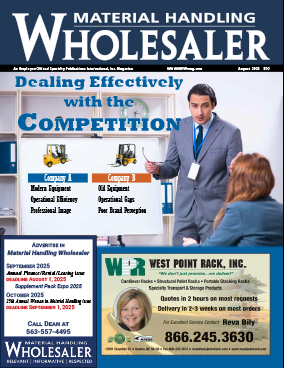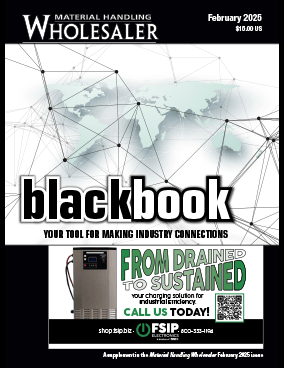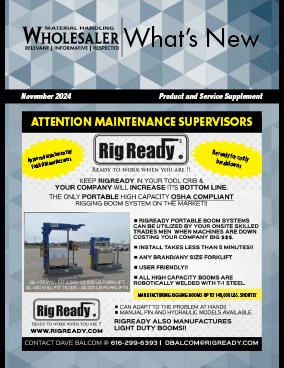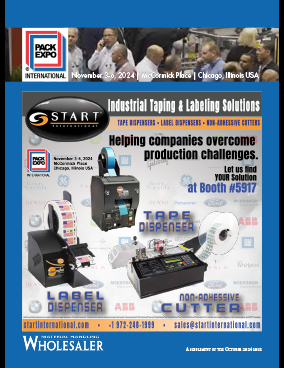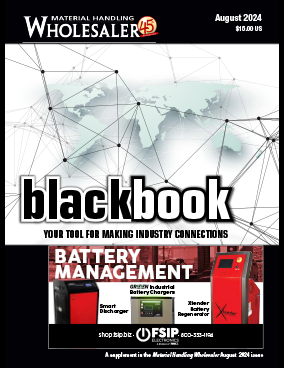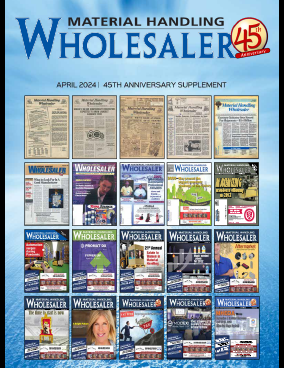Tackling safety within a warehouse is a multi-layered endeavor. From equipment to building maintenance to the workers themselves, material handling operations present a variety of safety considerations. I had safety conversations with a few industry experts on various workplace safety aspects.
This year, Forklift Safety Day by the Industrial Truck Association returns for its 12th year on Tuesday, June 10, in Washington, D.C. and online.

“It’s open for everybody; in person at the National Press Club and online,” said Brian Feehan, president of ITA.
He said that over 500 people joined the event online last year, and close to 100 attended in person. Registration is open until the day of the event, and those attending online will receive a link upon registration.
Attendees in the past have encompassed a broad audience, including end users, private industry representatives, and academic and government officials, according to Feehan, who noted that forklift use touches nearly every segment of the economy.
Feehan said this year’s primary message is that operator training is critical to maintaining workplace safety. “We embrace technology. But at the end of the day, when it comes to operator training, you’ve got to have hands-on training,” he said.
According to Feehan, speakers will also focus on adopting best practices in specific environments and building a good safety culture. Forklift Safety Day falls by design during the National Safety Council’s Safety Month. Feehan said other countries have also adopted the idea of Safety Day and are promoting similar events worldwide. “It really has expanded in a global push,” he said.
ITA recently released its publication, “Lifting America,” focusing on economic impact. ”In 2023, we’re at about $36.6 billion in annual contributions to GDP, up to 257,000 jobs in the industry, and $8.4 billion in taxes. All of the numbers across the board have really gone up,” Feehan said.
For those who have not attended the safety day previously, Feehan encouraged checking it out. ”If you’ve thought about safety in your workplace, if you’re looking for some new ideas and fresh perspective, it’s a great opportunity to get a wealth of knowledge,” he said.
At the upcoming National Forklift Safety Day, with a theme of “Every Move Matters,” some of the focus will be on how a multitude of small decisions can lead to a safer whole.
“It’s a timely reminder that safety isn’t defined by a single action but a series of everyday decisions,” said Tom Lego, Toyota Material Handling Brand Ambassador, in an email. “At Toyota Material Handling, we believe promoting forklift safety starts with awareness and extends to the training, tools, and culture that reinforce safe practices at every level,” Lego said.
According to Lego, Toyota has supported National Forklift Safety Day since its inception. “For over a decade, we’ve used this day to advocate for operator education, highlight emerging best practices, and reinforce the importance of making safety a shared responsibility,” he said.
Lego said a safe work environment begins with consistency. “Safety isn’t just a checklist, it’s a culture,” he said, advising making safety part of the everyday routine of an operation.
“Take the time to do thorough pre-operation checks. Speak up when you see something that doesn’t look right. Encourage peer-to-peer accountability and celebrate safe behaviors,” said Lego, adding that regular training and refreshers are also important. “Whether it’s buckling a seatbelt or scanning your surroundings, small actions can make a big impact,” he said.
For more information on Forklift Safety Day, visit https://www.indtrk.org/
Keeping out unwelcome guests
With the high level of activity in material handling facilities, rodents, insects, and other living organisms can present concerns. Pests like rodents, cockroaches, flies, and others can carry diseases that can wreak havoc on employees and customers. According to Western Pest Services, they can also damage a building structure and increase the risk of fires.
Nicolas Ellis, MS, PhD, is a board-certified and regional entomologist with the organization. Dr. Ellis works in various urban markets and environments.
According to Dr. Ellis, food safety is a particularly important area, and Western Pest Services has an interface that companies can use to offer guidance and services for rodent and insect control. “Insects could be flies, which very readily enter through dock doors or pedestrian doors,” he said, adding that they can try to lurk or hide elsewhere. “When it comes to food supply and logistics, rodents are always a major concern. They are highly adaptable and choose to live around and among people,” Dr. Ellis said.
“They will find ways to survive around us. They can be very difficult to control. On the other hand, insects can be brought in and are not even noticed. Beetles can hide and be inside things unknown to anybody.” Ellis added.
The key is to be preventative, according to Dr. Ellis, who said visual inspections can be done by an organization’s quality control workers or by experts like those at Western Pest Services. ”That’s very successful,” he said of preventative inspections, noting that there is a certain consistency to pursuing safety in this vein.
“When it comes to pest control, the pests don’t change,” said Dr. Ellis, who said that the industry literature and science behind pest control point to prevention as pivotal. “Our technicians can’t always be on site every time a truck comes up. One of the goals we have is to work with the quality measures on site.” This is helpful in empowering employees, according to Dr. Ellis. “The message resonates. They don’t feel helpless anymore,” he said.
He noted that Western Pest Services develops programs to meet its customers’ criteria. “They’re always interested in knowing what they can do to optimize their pest control,” Dr. Ellis said. He said that when the logistics of a facility are complex, more challenges are presented. The more touchpoints there are for products, the more opportunities there are for pests, according to Dr. Ellis.
And while many aspects of pest control remain static, shifts can be noted elsewhere. Asked about how climate change may impact conditions, Dr. Ellis stressed the evidence of new conditions in how some insects carry illness and affect humans. ”Is it having a direct impact on the clients I work with? I can’t say that for sure,” he said. Western Pest Services can offer “very robust mechanisms for overcoming climatic challenges,” Dr. Ellis said.
Overall, having a company on board that is competent in early warning surveillance is key, according to Dr. Ellis, who said there are a lot of tools for electronic monitoring. “There are ways to gather data about these pests and what they’re doing,” he said. “We take science and we apply it. We know what to expect. We use the tools that we have to exploit whatever weaknesses they have, and that’s how we’ve been successful.”
Preventing falls
The American Society of Safety Professionals is a non-profit organization that advocates safety in the field. According to a press release, the organization works to help ensure occupational safety and provides tools to protect people, property, and the environment.
Recently, the organization released another installment of its standards education series called “Stand Up for Standards: ANSI/ASSP Fall Protection and Restraint Implementation.”
According to a statement, the presentation included an overview and best practices for implementing Z359 standards, which include fall protection equipment and systems for climbing, work positioning, fall arrest, rescue, evacuation, and other fall hazards.
The webinar included practical guidance, safety resources, real-world experiences, and voluntary consensus standards to help attendees.
According to a press release, the American Society of Safety Professionals marks the 12th annual National Safety Stand-Down to Prevent Falls in Construction in May. This event is part of a year-round campaign led by the Occupational Safety and Health Administration (OSHA).
Falls from height are the leading cause of death for construction workers, with more than 300 fatalities and 20,000 serious injuries occurring each year, according to the U.S. Bureau of Labor Statistics, the statement said.

“No matter the job, worker injuries and fatalities are preventable,” said fall protection expert Thom Kramer, P.E., CSP, vice president of finance on ASSP’s Board of Directors, in the release. “Companies can create safe environments by using prevention through design principles, providing the right equipment and training to everyone involved. It’s also a great idea to implement fall protection programs that follow our Z359.2 and A10.32 consensus standards.”
In the release, Kramer said falls from height are typically the biggest exposure that employers face related to serious injuries and fatalities.
In an interview with Material Handling Wholesaler, Kramer said there are various ways to support fall protection, including the use of technological tools. The best time to install fall prevention systems is during the design phase, when the technology can be seamlessly integrated, Kramer said.
“After the contractor has left is the most ineffective time”, he said. “Typically, systems have to be inspected on an annual basis and recertified every five years”, according to Kramer.
Asked about more material handling operations turning to the use of vertical real estate in facilities, Kramer acknowledged the trend and said the practice makes fall protection “even more critical.” ”It increases the risk,” he said, noting how conveyance systems are bringing material from one level to another.
“Now they have to do protection on the third and fourth level,” said Kramer, who said one example of protections to have in place is systems for rescuing people working 50 and 60 feet in the air.
Kramer noted that the increased use of automation in material handling allows workers to focus more on other key tasks related to operations and helps mitigate ergonomic issues. “The ergonomic protections we’re giving employees are shockingly good. At the same time, we’re creating other hazards,” he said, of new technologies.
According to the statement, OSHA offers resources for conducting a safety stand-down. The information can be found by visiting https://www.osha.gov/stop-
About the Author:
Eileen Mozinski Schmidt is a writer and journalist based in the Greater Milwaukee area. If your company would like to be featured, email editorial@MHWmag.com




